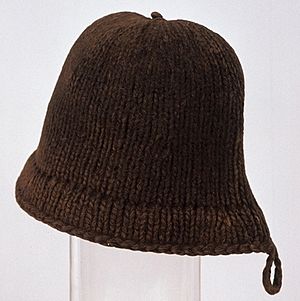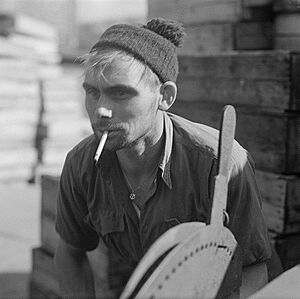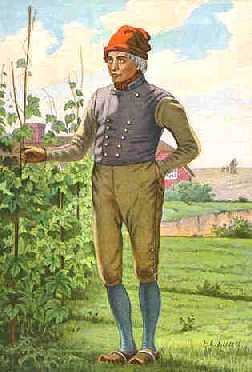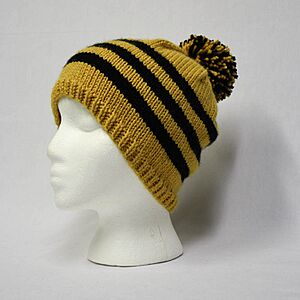Knit cap facts for kids
A knit cap is a warm hat, usually made from wool or synthetic fibers. It's designed to keep your head warm when it's cold outside. Most knit caps are simple and fit snugly on your head.
People all over the world wear knit caps, especially in cold places. They have many different names depending on where you are. For example, in Canadian English, a knit cap is often called a toque, touque, or tuque.
Contents
How Knit Caps Are Made
Most knit caps are shaped to be narrower at the top. The stretchy fabric hugs your head, which helps the cap stay on. Sometimes, knit caps have a fluffy ball called a pom-pom or loose tassels on top.
Some caps have a folded edge, called a brim, while others don't. They can be worn tightly on the head or a bit loose. In the Andes Mountains in South America, some caps have ear flaps that can be tied under the chin. A special type of knit cap, called a balaclava, can be pulled down to cover most of the face, leaving only openings for the eyes or mouth.
Some newer knit caps are made like a tube with a string at one end. You can wear this type as a neck warmer, or pull the string tight to close one end and wear it as a hat.
History and Different Names for Knit Caps

One of the earliest types of knitted wool caps was made in the Welsh town of Monmouth in the 15th century. These were called "Monmouth caps."
The oldest Monmouth cap we know of is kept at the Monmouth Museum. It was made from thick wool and knitted in a circle from the bottom up. The top was rounded, and the leftover yarn was tied to make a small bump, sometimes called a button. These hats were made waterproof by a process called felting, which also made them shrink.
Thousands of Monmouth caps were made a long time ago. But because they were cheap and could easily unravel, not many of them still exist today.
For hundreds of years, knit caps have been very common for people who work outdoors, like sailors, fishers, and hunters. They are still used today in cold parts of North America, Europe, Asia, and other cold regions.
Because they are worn all over the world, knit caps have many different local names. In some English-speaking places, they are called a beanie. However, in parts of Canada and the United States, 'beanie' can also mean a different type of hat that is made from sewn fabric panels, not knitted.
A knitted cap with ear flaps is often called a bobble hat, toboggan, or sherpa. In the southern United States, the word toboggan is sometimes used for knit caps.
Members of the United States Armed Forces often call a knit cap a watch cap. This is because it's the hat they wear when "standing watch" on a ship or at a guard post. They also sometimes call it a snookie cap.
In some parts of Pennsylvania, it's known as a tossle cap. It might also simply be called a winter hat.
Other names for knitted caps include: woolly hat (in British English) or wool hat (American English); sock hat, knit hat, poof ball hat, bonnet, sock cap, stocking cap, skullcap, ski hat, sugan, or chook.
Balaclava Caps
A special type of pull-down knit cap was known as an Uhlan cap or Templar cap in the British army. During the Crimean War, people sent handmade pull-down caps to the British troops to protect them from the very cold weather. These caps became known as a Balaclava helmet or simply balaclava, named after the Battle of Balaclava.
In Scandinavia, caps similar to today's knit caps with a pom-pom have been used since the Viking Age and maybe even earlier. The names tophue (in Danish), topplue (in Norwegian), and toppluva (in Swedish) all mean 'top cap', referring to the pom-pom.
An old statue from the Viking Age, possibly of the god Freyr, shows a pointed cap with a pom-pom. Early caps were probably sewn or made with a technique called nålebinding. But from the 17th century, they started to be knitted. These caps became very popular in the 18th and 19th centuries and are still part of many traditional Scandinavian outfits for men.
Canadian Tuque Caps

In Canadian English, knit caps are often called a tuque (pronounced 'took'). You might also see it spelled toque or touque. A classic Canadian tuque has a pom pom on top, but there are many different kinds. It's a hat for cold weather and usually not worn indoors. The word toque is also used in parts of New England in the United States. In Michigan's Upper Peninsula, it's called a chook or chuke.
Sometimes, a tuque with a brim (like a baseball cap) is called a bruque by snowboarders.
The word tuque comes from French Canadian language. It's related to the French word toque, which originally meant a type of traditional hat, and now refers to a chef's hat. The Canadian term likely came from the long hats worn by the Voyageurs, who were fur traders exploring North America.
In the 12th and 13th centuries, women wore fancy "toques" made of velvet or satin. In the late 16th century, brimless black velvet toques were popular for both men and women.
The tuque looks a bit like the Phrygian cap, which was a symbol of freedom. Because of this, a red tuque became a symbol of French-Canadian nationalism during the 1837 Lower Canada Rebellion. Even though it has this history, the tuque is also seen as a symbol of Canadian identity in general, because so many Canadians wear it.
British Bobble Hats
In England, a knit cap is often called a bobble hat, whether it has a pom-pom or not.
Bobble hats were traditionally just practical hats for cold weather. In the early 2000s, they became very popular and even a luxury fashion item, sometimes with real fur bobbles.
In the late 1900s in the United Kingdom, bobble hats were often linked to old-fashioned or un-stylish clothing, or to older football fans. They were popular in team colors during the 1960s and 1970s. Along with football scarves, the bobble hat was seen as a traditional part of working-class football fan gear.
Knit Caps in Pop Culture
Knit caps are common in cold places and are worn in many ways around the world. They are often seen as the typical hat for dockworkers and sailors in movies and TV shows.
Many famous characters in movies and TV shows wear knit caps:
- Bill Murray wore a red knit cap in the movie The Life Aquatic with Steve Zissou, possibly like the one worn by French oceanographer Jacques Cousteau.
- Michael Nesmith from The Monkees wore one in his TV series.
- Jay wears one in the films of the View Askewniverse.
- "Relic" from the Canadian TV series The Beachcombers wore one.
- Hanna-Barbera's character Loopy De Loop wore a knit cap.
- Michael Parks wore one as James "Jim" Bronson in Then Came Bronson.
- Robert Conrad wore one in Centennial.
- Bruce Weitz's character Mick Belker wore one in almost every episode of Hill Street Blues.
- Everest from PAW Patrol wears a teal knit cap.
- Characters in South Park, like Eric Cartman and Stan Marsh, usually wear knit caps.
- Jayne Cobb from Firefly wore an orange sherpa knit cap that his mother sent him.
- Compo from the British TV show Last of the Summer Wine almost always wears a knit cap.
- Edd from Ed, Edd n Eddy wears a black, loose knit cap to cover something on his head he's embarrassed about.
Musicians also wear knit caps:
- The Edge, the guitarist for the band U2, often wears a knit cap when performing or in interviews.
- Tom DeLonge, former guitarist and singer for Blink-182, is known for wearing one during live shows.
- Rob Caggiano, a music producer, is often seen in a black knit cap.
- Lee Hartney from The Smith Street Band regularly wears a black knit cap.
- Canadian singer Daniel Powter wore a blue knit cap in his music video for "Bad Day".
- Knit caps are also commonly worn by hip hop artists.
Santa Claus is often shown with a knit cap or a sewn cap that looks like the traditional Scandinavian knit cap with a pom-pom. This comes from Germanic and Scandinavian traditions. The Scandinavian tomte (a type of gnome) is also usually shown with a red knit cap.
Famous examples of tuques (Canadian knit caps) in pop culture include:
- The SCTV characters Bob and Doug McKenzie wore tuques as part of their signature outfits.
- Toronto Maple Leafs goalie Jonathan Bernier wore a tuque over his helmet during a special outdoor hockey game in 2014.
- The 1984 Québécois film La guerre des tuques (The War of the Tuques) is about a huge snowball fight.
- Jacques Plante, a famous Hall of Fame goaltender for the Montreal Canadiens in the 1950s, was known for wearing a tuque.
- José Théodore, another Canadiens goalie, wore a tuque on top of his goalie mask during a very cold outdoor game in 2003.
- La Tuque is a town in Quebec named after a nearby hill that looks like a tuque.
See also
 In Spanish: Gorro para niños
In Spanish: Gorro para niños





